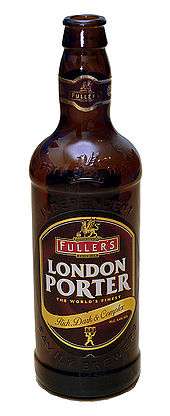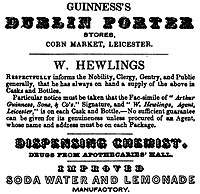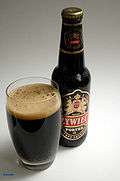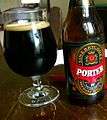Porter (beer)
Porter is a style of beer that was developed in London, England in the early eighteenth century.[1] It was well-hopped and dark in appearance due to the use of brown malt.[2][3] The name originated due to its popularity with street and river porters.[4]

The popularity of porter was significant, and it became the first beer style to be brewed across the world, and production had commenced in Ireland, North America, Sweden and Russia by the end of the eighteenth century.[1]
The history of stout and porter are intertwined.[5] The name "stout", used for a dark beer, is believed to have come about because strong porters were marketed under such names as "extra porter", "double porter", and "stout porter". The term stout porter would later be shortened to just stout. For example, Guinness Extra Stout was originally called "Extra Superior Porter" and was only given the name "Extra Stout" in 1840.[6] Even today, there are not many distinctions between stouts and porters, the terms are used by different breweries almost interchangeably to describe dark beers, and the two styles have more in common than in distinction.[7]
History
Eighteenth and nineteenth century
In 1802, John Feltham wrote a version of the history of porter that has been used as the basis for most writings on the topic. Very little of Feltham's story is backed up by contemporary evidence; his account is based on a letter written by Obadiah Poundage (who had worked for decades in the London brewing trade) in the 1760s. Feltham badly misinterpreted parts of the text, mainly due to his unfamiliarity with eighteenth-century brewing terminology.[8] Feltham claimed that in eighteenth-century London a popular beverage called three threads was made consisting of a third of a pint each of ale, beer and twopenny (the strongest beer, costing two pence a quart). About 1730, Feltham said, a brewer called Harwood made a single beer called Entire or Entire butt, which recreated the flavour of "three threads" and became known as "porter".[9]
Porter is mentioned as early as 1721, but no writer before Feltham says it was made to replicate "three threads". Instead, it seems to be a more-aged development of the brown beers already being made in London.[10] Before 1700, London brewers sent out their beer very young and any ageing was either performed by the publican or a dealer. Porter was the first beer to be aged at the brewery and dispatched in a condition fit to be drunk immediately. It was the first beer that could be made on any large scale, and the London porter brewers, such as Whitbread, Truman, Parsons and Thrale, achieved great success financially.
Early London porters were strong beers by modern standards. Early trials with the hydrometer in the 1770s recorded porter as having an OG (original gravity) of 1.071 and 6.6% ABV.[11] Increased taxation during the Napoleonic Wars pushed its gravity down to around 1.055, where it remained for the rest of the nineteenth century. The popularity of the style prompted brewers to produce porters in a wide variety of strengths. These started with Single Stout Porter at around 1.066, Double Stout Porter (such as Guinness) at 1.072, Triple Stout Porter at 1.078 and Imperial Stout Porter at 1.095 and more. As the nineteenth century progressed the porter suffix was gradually dropped.

Guinness Porter, 1840
The large London porter breweries pioneered many technological advances, such as the use of the thermometer (about 1760) and the hydrometer (1770). The use of the latter transformed the nature of porter. The first porters were brewed from 100% brown malt. Now brewers were able to accurately measure the yield of the malt they used, and noticed that brown malt, though cheaper than pale malt, only produced about two-thirds as much fermentable material. When the malt tax was increased to help pay for the Napoleonic War, brewers had an incentive to use less malt. Their solution was to use a proportion of pale malt and add colouring to obtain the expected hue. When a law was passed in 1816 allowing only malt and hops to be used in the production of beer (a sort of British Reinheitsgebot), they were left in a quandary. Their problem was solved by Wheeler's invention of the almost black (kilned) patent malt in 1817. It was now possible to brew porter from 95% pale malt and 5% patent malt, though most London brewers continued to use some brown malt for flavour.[12]
Until about 1800, all London porter was matured in large vats, often holding several hundred barrels, for between six and eighteen months before being racked into smaller casks to be delivered to pubs. It was discovered that it was unnecessary to age all porter. A small quantity of highly aged beer (18 months or more) mixed with fresh or "mild" porter produced a flavour similar to that of aged beer. It was a cheaper method of producing porter, as it required less beer to be stored for long periods. The normal blend was around two parts young beer to one part old.[13]
After 1860, as the popularity of porter and the aged taste began to wane, porter was increasingly sold "mild". In the final decades of the century, many breweries discontinued their porter, but continued to brew one or two stouts. Those that persisted with porter, brewed it weaker and with fewer hops. Between 1860 and 1914, the gravity dropped from 1.058 to 1.050 and the hopping rate from two pounds to one pound per 36 gallon barrel.[12]
Twentieth and twenty-first century
_-_Allentown_PA.jpg)
During the First World War in Britain, shortages of grain led to restrictions on the strength of beer. Less strict rules were applied in Ireland, allowing Irish brewers such as Guinness to continue to brew beers closer to pre-war strengths. English breweries continued to brew a range of bottled, and sometimes draught, stouts until the Second World War and beyond. During the Second World War, because of the Irish Free State's official policy of neutrality, this period was not technically considered wartime, however the country suffered similar resource scarcities and consequent rationing to the United Kingdom, thus this period was officially named The Emergency there. They were considerably weaker than the pre-war versions (down from 1.055–1.060 to 1.040–1.042) and around the strength that porter had been in 1914.[12] The drinking of porter, with its strength slot now occupied by single stout, steadily declined, and the last porter was produced in 1941.[14]
The Anchor Brewing Company started brewing a Porter in 1972 and was bottled in 1974 that kickstarted the revival of the style which began in 1978, when the Penrhos microbrewery introduced a porter.[15] A little later, Timothy Taylor began to brew a porter as well. There are now dozens of breweries in Britain making porter, with Fuller's London Porter winning gold and silver medals at the 1999, 2000 and 2002 International Beer & Cider Competitions, and CAMRA's Supreme Champion Winter Beer of Britain silver medal in 2007, with Wickwar Brewery's Station Porter winning gold in 2008.[16][17][18]
Many breweries brew porters in wide varieties, including, but not limited to, pumpkin,[19] honey, vanilla, plum,[20] and chocolate.[21] Specialized porter brews continue the tradition of ageing in barrels, and the use of bourbon barrels is not uncommon.
Ireland
Porter was first brewed in Ireland in 1776 and, although Arthur Guinness did not start brewing until 1787, he had phased out all other types of beer from his Guinness Brewery by 1799.[22][23] Beamish and Crawford in Cork and Murphy's Brewery followed suit and abandoned ales in favour of porter. The move from porter to stout was made when Arthur Guinness realised that he would pay less tax if he used unmalted and roasted barley in his beer.[22]
In Ireland, especially Dublin, the porter was known as "plain porter" or just "plain". This is the drink referred to in Flann O'Brien's poem "The Workman's Friend": "A pint of plain is your only man."[24] By contrast, extra-strong porter was called Stout Porter. The last Guinness Irish porter was produced in 1974, though the company launched a "revival" based upon a 1796 recipe in 2014.[25]
.jpg)
After the invention of malted barley roasted until black to impart a darker colour and distinct burnt taste to the beer in 1817, Irish brewers dropped the use of brown malt, using patent malt and pale malt only, while English brewers continued using some brown malt, giving a difference in style between English and Irish porters.
United States
Porter was being commercially brewed in the United States in the eighteenth century, especially in New England and Pennsylvania. After the introduction of lagers in the United States in the 1850s, breweries began brewing their porters with lager yeast rather than a top-fermenting one. In addition, these American porters often included adjuncts such as maize, molasses, and Porterine.[26] Porterine was developed in America as a brewer's tool, added in the wort of lighter beers, to add colour and flavour which emulate that of a porter. Porterine is made from the slow cooking of corn syrup, which concentrates the sugars in the substance. With this concentration comes the caramel-like colour and consistency of Porterine.[27] With the advent of the craft brewing movement, many microbreweries produce porters and stouts with traditional methods as well as the American techniques.
Baltic porter
Baltic porter is a version of imperial stout which originated in the Baltic region in the nineteenth century.[28] Imperial stouts exported from Britain in the eighteenth century were popular in the countries around the Baltic Sea, and were recreated locally using local ingredients and brewing traditions. Early versions were warm fermented until the late nineteenth century when many breweries began to brew their porter with cool fermentation. Baltic porters typically have a minimum gravity of 18 degrees plato and a high alcohol content, even over 10% abv.[28] They are produced in Finland, Estonia, Latvia, Lithuania, the Czech Republic, Germany, Poland, Russia, Ukraine, Denmark, Sweden and the United States.
Baltic porter is a specialty of many Polish breweries, with the country's oldest being produced by Żywiec in 1881.[28] Finland's Sinebrychoff has been brewing Baltic porters in Helsinki since the 1860s,[29][30] while Estonia's Põhjala is a newcomer specialising in barrel-aged porters.[31] In Denmark the word "porter" is synonymous with "imperial stout"[32] and Wiibroe's Baltic porter (now brewed by Carlsberg) is known by both names.[33] Porter was brewed in Germany from 1853 until 1990, when production ceased in East Germany after reunification. In 1998, the Hoepfner brewery of Karlsruhe resumed production of an old recipe. It was followed by other brewers such as Neuzeller Kloster Brewery and Bergquell Brewery who brew an 8% abv Baltic porter.[34][35]
Baltic Porter Day, started in Poland in 2016 by Marcin Chmielarz, is celebrated annually on the third Saturday of January.[36]
Porters of the Baltic region

Żywiec
Porter bałtycki
Poland
Sinebrychoff
Koff Porter
Finland
Baltika
Baltika 6 Porter
Russia
Carlsberg
Carnegie Porter
Sweden
A. Le Coq
Porter
Estonia.jpg)
Thisted Bryghus
Limfjords Porter
Denmark
References
- Cornell, Martyn. The Geography of Beer. Springer Nature. p. 7. ISBN 978-3-030-41654-6.
- Dornbusch, Horst, and Garrett Oliver. "Porter." The Oxford Companion to Beer. Ed. Garrett Oliver. 2012. Print.
- Amber, Gold & Black; Cornell, Martyn; The History Press UK, 2010, p.54
- "The Picture of London", John Feltham, 1802, p26, states it "obtained the name porter" because it was "very suitable for porters and other working people".
- "Porter and Stout". CAMRA. Retrieved 5 April 2010.
- "Guinness's Brewery in the Irish Economy 1759–1876", Patrick Lynch and John Vaizey, pages 150–151.
- Johnston, Zach (28 March 2018). "Picking Apart The Minute Differences Between Porter And Stout". Uproxx. Retrieved 21 January 2020.
- Amber, Gold & Black; Cornell, Martyn; The History Press UK, 2010, p.55-56
- Rees (1819). "Porter". Cyclopedia. 38. Online edition transcribed by James Sumner. Archived from the original on 13 January 2010.
- Cornell, Martyn (2010). Amber, Gold & Black. The History Press. p. 53.
- "A History of Beer and Brewing" Ian S. Hornsey, 2003 p.436
- Whitbread brewing records held at the London Metropolitan Archives
- "The Brewer" by William Loftus, 1863 p.50
- Cornell, Martyn. The Geography of Beer. Springer Nature. p. 21. ISBN 978-3-030-41654-6.
- "Endangered beers | Zythophile". Zythophile.wordpress.com. 22 May 2012. Retrieved 9 November 2012.
- "Fuller's Brewery". Fullers-ales.com. Retrieved 5 April 2010.
- "'Station Porter' steams in to be voted Best Winter Beer in the Land!". Camra.org.uk. 17 January 2008. Retrieved 5 April 2010.
- "Wickwar Brewing". Archived from the original on 22 May 2009.
- "Four Peaks Brewery – Tempe, Arizona". Fourpeaks.com. 27 April 2004. Retrieved 5 April 2010.
- "Chilli plum porter – Waen Brewery". Retrieved 1 August 2012.
- "Chocolate Stout – Limited Edition – Harpoon Brewery – Brewers of Harpoon IPA and UFO Hefeweizen". Harpoon Brewery. Retrieved 5 April 2010.
- Protz, Roger (2010). 300 Beers to Try Before You Die. St Albans (UK): Campaign for Real Ale Ltd. p. 137. ISBN 978-1-85249-273-1.
- Tierney-Jones, Adrian (2010). 1,001 Beers You Must Try Before You Die. London (UK): Octopus Books (Lagardère Publishing). p. 700. ISBN 978-1-84403-682-0.
- At Swim-Two-Birds, Flann O'Brien, ISBN 1-56478-181-X.
- "Guinness brings Dublin Porter back to life". Protz on Beer. 9 September 2014. Retrieved 7 April 2020.
- Jankowski, Ben. "American Porters: Marching to Revolutionary Drummers". BrewingTechniques. Retrieved 8 April 2015.
- "BT - American Porters: Marching to Revolutionary Drummers [sidebar]". morebeer.com. Archived from the original on 6 April 2013. Retrieved 27 April 2013.
- Klemp, K. Florian. "Big Baltic Porter". All About Beer Magazine. 29 (1).
- Sinebrychoff.fi. Sinebrychoff Porter. Archived 6 October 2019 at the Wayback Machine (in Finnish)
- "Protz: Back to black: Baltic porter is heading for pole position". morningadvertiser.co.uk.
- "Cellar Series — Põhjala Brewery". pohjalabeer.com.
- [https://www.ale.dk/index.php?id=665> Danske Ølentusiaster. Oversigt over øltyper.] (in Danish)
- Wiibroe.dk. Wiibroe Porter (Imperial Stout). (in Danish)
- Braukultur-franken.de. Porter in Deutschland. (in German)
- Bergquell Brauerei Löbau. (in German)
- Dredge, Mark (2018). The Beer Bucket List: Over 150 essential beer experiences from around the world. UK: Dog n Bone. ISBN 1911026275.
| Wikimedia Commons has media related to Porter. |